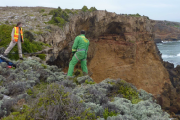Our ability to understand more about these voids and their size and position is a considerable advantage, improving safety and risk assessment. It will undoubtedly lead to saving lives too.
There are two main types of subterranean voids: naturally occurring ones created through geological faulting, landslides and washouts millions of years ago and man-made cavities often created by burst water mains and, particularly, old mine workings.
One such investigation was to determine the extent and size of some natural cave systems on the SW coast of Victoria near Warnambool. The cavities had been created long ago by the natural elements of wind and sea erosion and now are a maternal roost home for a colony of endangered Bats - Southern Bent-wing Bat . The reason Austech was asked to assist in the investigation was to assess how far the cavities extended into the land from the shoreline cliffs and how close did they come to the farmland surface.
 |  |
Initially the investigations had involved physical entry to the cave system, and then from inside survey the internal extents via standard techniques with a total station. However, whilst this gave good results for the floor and walls, the roofs of the caves were often inaccessible or impossible to see due to overhangs and various obstructions. Hence, it was difficult to be confident about the thickness of the cave roof. The physical access was difficult as it involved rap-sailing down cliff faces, and carrying gear across rocks ahead of incoming tides. So a better way to collect the data of the was needed! The survey consultants (Beam Surveys) came up with the idea that a robotic remote controlled cavity scanning system would be ideal for this scenario as it could be fed down to the cave systems via a number of holes that had formed on the paddock surface and went down though to the voids.
 |  |
Some of the challenges:
The scanning needed to be done at night in order to minimise disturbance to the bats where many of the females are about due to give birth to their young in these cave roosting zones. Due to the unknown amount of ground cover above the cave ceiling, we couldn't approach too close to the cave openings without being harnessed and anchored with safety lines.
The Deployment
On arriving at the site at dusk, we prepared the gear ready for deployment. Actual lowering of the remotely controlled scanner couldn't be done until we were confident the majority of the bats had left their roosting spots for the night. Whilst the scanning would not harm the bats in any way, it was preferred we keep any disturbance to an absolute minimum. Once nightfall had arrived and the bats had flown out through the access points on the cliffs, it was time to begin.
Outcome
Once the various scans had been completed and merged, it was possible to produce a georeferenced "point cloud" of the cave system. This was in turn merged with the previous work to create a full picture of the zones including measurements of "ceiling thicknesses" at various points. The results were used by the client to document concerns on the stability of the cave systems as well as the integrity of the paddock surface.
 |  |
According to Dr. Lindy Lumsden from the Arthur Rylah Institute for Environmental Research, "the use of the Remote controlled scanning instrument allowed them to gain valuable data and insight into the extent and condition of the voids via access holes which was much easier and safer than previous."
Mr Glenn Williams from BEAMS surveys commented that "deployment of the scanner was relatively simple and efficient and gave clear and reliable interpretation of the 3 dimensional point cloud."
Client:
Arthur Rylah Institute for Environmental Research(ARI). ARI is a leading centre for applied ecological research, located in Heidelberg, Melbourne. They are the biodiversity research base for the Department of Environment, Land, Water and Planning (DELWP) in Victoria.
Project Co-ordinator: Dr. Lindy Lumsden
Co- coordinating Consultant: BEAMS Surveys, Glenn Williams
Austech Surveying & Mapping wish to acknowledge Beams Surveys and ARI for their expertise, professional input and co-operation.
Refs:
http://www.environment.gov.au/cgi-bin/sprat/public/publicspecies.pl?taxon_id=87645
http://bird.net.au/bird/index.php?title=Common_Bent-wing_Bat
